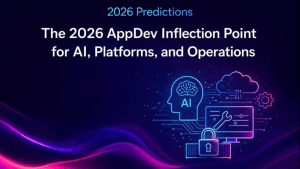By 2026, most enterprises will be operating in a multi-cluster, multi-platform, and multi-environment world. In this landscape, service mesh adoption is no longer a theoretical exercise, it’s a strategic necessity.
In this episode of AppDevANGLE, I spoke with William Morgan, CEO and co-founder of Buoyant, the creators of Linkerd, the first-ever service mesh and a project that helped define the entire category. Our discussion centered on the evolution of the service mesh space, enterprise maturity, and the pressing need for operational simplicity.
From Hype to Reality
Back in 2016, service mesh was still an emerging concept. Today, Linkerd is powering critical systems at massive scale, as enterprises shift from experimentation to standardization.
“The modern adoption we’re seeing isn’t piecemeal,” William said. “These are organizations building real platforms across hundreds, sometimes thousands, of Kubernetes clusters.”
Kubernetes may have once been the playground of DevOps pioneers, but it has matured into a mainstream enterprise platform. And with that maturity comes serious expectations: security, reliability, observability, and scale are all areas where service mesh plays a central role.
Simplicity Is Possible
One of the most persistent myths in the market is that service meshes are too complex to justify the value.
“Operational complexity is the real enemy,” William explained. “Installing a mesh is easy. Running it at scale, in production, over time, that’s where things fall apart.”
That’s why Linkerd was built from the ground up with simplicity in mind:
- A Rust-based micro-proxy designed for security and performance
- An architecture that favors understandability and inspectability
- A relentless focus on reducing the burden of day-2 operations
The result? A service mesh that doesn’t require a PhD in distributed systems to use effectively.
Cross-Platform Support and Mesh Expansion
Linkerd’s latest 2.18 release includes experimental support for Windows workloads and expanded support for Linux VMs outside of Kubernetes. This speaks to a major shift: service mesh is no longer just for cloud-native apps.
“There are parts of the stack you’re not going to move to Kubernetes,” William said. “We’ve focused on making the mesh expandable so enterprises can apply the same security, reliability, and observability guarantees across their entire architecture.”
With GitOps workflows, multi-cluster communication, and support for legacy infrastructure, Linkerd is evolving into a connectivity platform for the modern, hybrid enterprise.
Why This Matters for AI and LLMs
It wouldn’t be 2025 if we didn’t talk about AI and large language models (LLMs). As these workloads become increasingly distributed across clusters and clouds, service meshes are becoming essential for maintaining secure, observable communication.
“We’ve got customers doing advanced things with LLMs and others still running legacy Windows apps,” William shared. “Both are valid. Both require the same foundational communication layer.”
Service mesh provides the glue between services, whether they’re modern AI models or 10-year-old line-of-business apps. And that glue needs to be resilient, secure, and easy to manage.
The Path to Adoption
The message from this conversation shows that service mesh is not too complex, and yes, the juice is absolutely worth the squeeze. Especially when simplicity is part of the design.
For those just getting started, Buoyant offers an enterprise distribution of Linkerd available at buoyant.io, complete with self-paced courses, webinars, and documentation to help you ramp up quickly.
“Whether you’re a practitioner or a decision-maker, the resources are there,” William said. “We’re here to help organizations move from experimentation to enterprise adoption.”
Service mesh is a critical enabler of secure, scalable, and observable application architectures. If your organization isn’t using one yet, now’s the time to start. And if simplicity matters (and it should), Linkerd is worth a close look.
Stay tuned for more insights from AppDevANGLE as we continue exploring the tools, trends, and talents shaping the future of application development.



